Chapter 17.480
URBAN VILLAGE COMMERCIAL DESIGN CRITERIA
Sections:
Article 1. Site Design and Orientation: Applicable to All Development in the UVC Zone
17.480.010 How to use the design criteria.
17.480.020 Site design – Streets, trails and open space.
17.480.030 Site design and orientation – Location and use of centers and common open spaces.
17.480.040 Site design and orientation – Gateways and focal points.
17.480.050 Site design and orientation – Pedestrian/sidewalk orientation.
17.480.060 Site design and orientation – Fences and walls adjacent to pedestrian scale streets.
Article 2. Commercial and Mixed Use Building Design, Landscaping, and Signs
17.480.070 Building design – Commercial and mixed use.
17.480.080 Building design – Creation of human scale.
17.480.090 Building design – Building wall finishes for stand alone and corner site buildings.
17.480.095 Building design – Commercial use with ancillary drive-through component.
17.480.100 Landscape design for urban village and town centers.
17.480.110 Landscape design – Screening.
17.480.120 Landscape design – Existing trees.
17.480.130 Signs – Attached to the building.
17.480.140 Signs – Freestanding.
Article 3. Multifamily Projects in the UVC Zone (Including Townhouses of Five Units or More)
17.480.150 Multifamily – Site design – Orientation.
17.480.160 Multifamily – Site design – Parking location and design.
17.480.170 Multifamily – Site design – Mailboxes, site lighting, and bus stops.
17.480.180 Multifamily – Site design – Screening.
17.480.190 Multifamily – Building design – Neighborhood scale.
17.480.200 Multifamily – Building design – Privacy.
17.480.210 Multifamily – Building design – Facade, footprint, and roof articulation.
17.480.220 Multifamily – Building design – Entries.
17.480.225 Building design – Windows.
17.480.230 Multifamily – Building design – Materials and colors.
17.480.240 Multifamily – Signs.
Article 4. Other Residential Development in the UVC Zone: Duplex and Manufactured Housing, Cottage Housing and Single-Family Housing
17.480.250 Duplexes and manufactured housing – Applicability.
17.480.260 Duplex – Building design – Roof form and architectural detail.
17.480.270 Duplexes – Building design – Entries.
17.480.280 Duplexes – Building design – Garage design.
17.480.290 Duplexes – Building design – Materials and colors.
Article 5. Accessory Dwelling Units (ADU) in the UVC Zone
17.480.300 Accessory dwelling units – Site and building design – Privacy.
17.480.310 Accessory dwelling units – Building design – Entry features.
17.480.320 Accessory dwelling units – Building design – Materials and colors.
Article 6. Cottage Housing in the UVC Zone
17.480.330 Cottage housing – Site design.
Article 7. Definitions
Article 1. Site Design and Orientation: Applicable to All Development in the UVC Zone
17.480.010 How to use the design criteria.
The “requirement sections” in the following design criteria for Kitsap County apply to each project requiring conditional use review under Chapter 17.540 or 17.550. These design criteria are intended to supplement the development standards of the urban village commercial (UVC) zone. Where the provisions of this chapter conflict with the provisions of the UVC zone in Chapter 17.260, the provisions of the zoning district shall apply. The “guidelines” that follow each requirement statement are suggested ways to achieve the design intent. Each guideline is meant to indicate the preferred conditions, but other equal or better design solutions will be considered acceptable by the director or hearing examiner, so long as these solutions meet the intent of these sections. Where a requirement and/or guideline is followed by the abbreviations UVC – these requirements and/or guidelines are applicable to that particular zone found in Chapter 17.260.
(Ord. 534 (2016) § 7(5) (App. E) (part), 2016)
17.480.020 Site design – Streets, trails and open space.
A. Requirement. Arrange the streets and trails on the site so that the central internal open space and other community facilities can be accessed from all areas of the development without using an arterial street. The street layout shall be a modified grid street pattern adapted to the topography, unique natural features, and environmental constraints of the site. The street layout shall provide direct convenient access to the village, community focus areas, and internal open space areas, and shall showcase gateways and vistas. When making connections with adjacent neighborhoods, use traffic calming techniques where necessary. Public access shall be provided to water bodies as required by the Shoreline Management Act.
B. Guideline.
1. Street layout should have a minimum of two interconnections with the existing public street system rated as an arterial or collector (UVC).
2. The modified grid street pattern should define blocks that are two hundred fifty to three hundred fifty feet long (UVC).
3. When a block face is longer than three hundred fifty feet, an alley should be provided with through access to another street or alley (UVC).
4. Street layout that includes access from alleys to development is preferred (UVC).
5. Blocks should be designed to have a maximum length of six hundred feet from street to street and should either continue through the intersection or terminate in a “T” intersection directly opposite the center of a building, an internal open space area, or a view into a peripheral open space area (UVC).

Diagram of a modified grid street pattern built around a village. Note the connections to the surrounding street system. Each village must have at least two peripheral attachments.
6. A majority of the streets should be curved or terminated so that no street vista is longer than one thousand two hundred feet (UVC).
7. Provide a connected system of recreation areas, trails, and natural open spaces that are linked to the village and to natural features by streets or foot paths (UVC).
8. Provide street linkages, including pedestrian and bike facilities to adjacent developments and neighborhoods where possible (UVC).
9. Encourage pedestrian accessibility from adjacent residential neighborhoods by the use of through-block connections or other accessibility methods (UVC).
10. Where there are wildlife habitat areas on a village site, connect them to adjacent habitat areas to facilitate wildlife movement (UVC).
(Ord. 534 (2016) § 7(5) (App. E) (part), 2016)
17.480.030 Site design and orientation – Location and use of centers and common open spaces.
A. Requirement. Common open space shall be used for social, recreational, and/or natural environment preservation purposes. It shall include at least one internal open space (such as a village center park) that will serve as a center around which commercial, mixed use, and some higher density housing may be located (UVC).
B. Guideline.
1. An internal open space should be designed as a center park, town square, or urban park, should be an active gathering place in both day and evening, and should include places for strolling, sitting, social interaction, and recreation (UVC).
2. All commercial development in villages and centers should be within approximately six hundred feet of an existing or planned transit stop (UVC).
3. Surround the center park with a concentration of high-density development that may include commercial, residential, public and semi-public uses, community clubs, and community facilities (UVC).
4. The center park should be landscaped using elements such as formal gardens, walkways, monuments, statues, gazebos, fountains, park benches, children’s play equipment, small playfields and pedestrian-scale lamp posts (UVC).
5. Internal open spaces should be landscaped with trees and shrubs that do not visually obstruct scenic vistas (UVC).
6. A center green or plaza should have a distinct geometric shape. Streets with curbside parking may surround it, or it may abut major commercial, residential, civic, or other buildings, achieving a sense of scale and enclosure from them. While a center plaza should include trees, shrubs, and other landscape materials, it may emphasize decorative paving and other materials and surfaces appropriate to high pedestrian traffic areas (UVC).
(Ord. 534 (2016) § 7(5) (App. E) (part), 2016)
17.480.040 Site design and orientation – Gateways and focal points.
A. Requirement. Distinct or prominent buildings shall be located at gateways within a village at focal points, such as corner sites or landmarks, or at points of visual termination (UVC).
B. Guideline.
1. Prominent, monumental buildings or structures should mark gateways, focal points, or points of visual termination. This can be accomplished by using:
a. Distinct massing (such as the use of recessed entries, contrasting materials and architectural features that identify a bottom, middle and top of a building);
b. Additional height or the appearance of enhanced height (such as with the use of roof pitches and shapes, or cornice detail); and/or
c. Distinct architectural embellishments or ornamentation that break up and create variety on flat facades.
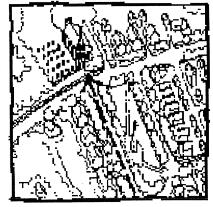
Focal points should terminate views down streets.
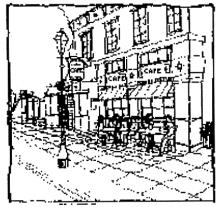
Gateway buildings should mark transition areas.
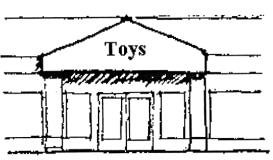
Provide a clear sense of entry upon arrival to the building.
(Ord. 534 (2016) § 7(5) (App. E) (part), 2016)
17.480.050 Site design and orientation – Pedestrian/sidewalk orientation.
A. Requirement. Create an interesting street that is visually attractive, and easy to use for pedestrians who will live, work or shop in the area.
B. Guideline.
1. Orientation.
a. Storefronts should face the core area, center park, and/or sidewalk of the streets on the site (UVC).
b. Buildings fronting on a center park, green or plaza should be at least two stories high (UVC).
c. Corner lots at major street entry points or village areas should be occupied by buildings or structures designed to emphasize their prominent location (UVC).
d. Locate service and delivery away from the main streets where possible, using alleys or side streets where possible (UVC).
e. Site design should accommodate transit on transit routes:
i. Bordering the site, and
ii. Within a core area that may have transit service (UVC).
2. Enhanced Pedestrian Access.
a. Direct pedestrian access should be provided from sidewalks and parking lots to building entrances, bus stops, and adjacent buildings. Where practical and consistent with the special provisions of the zone, parking aisles should be aligned perpendicular to the building, and pedestrian access should be separate from vehicular travel lanes (UVC).

Parking aisles perpendicular to a building entrance are preferred to allow easy and safe connection to building entrances. A convenient pedestrian walkway should be provided between a sidewalk and the building entrance where a sidewalk is separated by a parking lot.
b. Where a parking lot separates a building entrance from a sidewalk in the rights-of-way, a pedestrian walkway at least six feet in width should be provided connecting the street, the sidewalk and the building entrance. Such crossings should be clearly marked (UVC).
c. Define walkways with vertical plants (such as trees or shrubs) and lighting (UVC).
d. Street lights, utility poles, benches, trees, trash receptacles and similar streetscape fixtures should, to the greatest extent practical, be situated so that sidewalks in the rights-of-way have a passable width of at least five feet (UVC).
e. A walkway or shared bike/pedestrian network should be provided throughout the site that interconnects all dwelling units with other units, nonresidential uses, and common open space. Bike and pedestrian ways should be part of the street and alley network, but additional connections may be provided (UVC). Bike and pedestrian ways shall be designed in accordance with the Kitsap County Road Standards and shall evaluate the use of permeable pavements.
3. Enhanced Pedestrian Amenity. Walkway materials and patterns and pedestrian amenities such as benches, shelters, trash receptacles, street trees, pedestrian lighting, and drinking fountains should be coordinated to provide some uniformity of design throughout the site. Such improvements should comply with any applicable, adopted streetscape plan and should be incorporated into the village (UVC).
4. Possible amenities include:
a. Walls and planters that can be used for seating (UVC);
b. Seating in a variety of locations such as places that are sunny, sheltered from the rain and wind, or shaded in the summer (UVC);
c. Fountains or sculptures incorporated into small underutilized areas (UVC);
d. Seating that allows users to observe the activities of the street or enjoy a scenic view (UVC);
e. Plazas and courtyards with fountains, sculptures, mobiles, flower boxes, kiosks, banners, etc. (UVC);
f. Street vendor stations where allowed (UVC); and bike racks (UVC).
5. Add Character and Visual Diversity to Walkways.
a. Use a change in color and materials such as pavers, brick, stone, and exposed aggregate set in patterns to add interest and variety to walking surface (UVC).
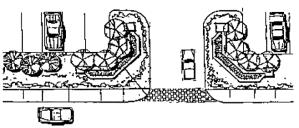
Pavers can be used to clearly identify pedestrian areas.
b. Identify street crossings through changes in color, materials, or patterns (UVC).
c. Separate the pedestrian from the street by placing planters, street trees and planter strips, bollards, or similar elements at the street edge of the sidewalk (UVC).
i. Planter strips shall include vegetation-based LID BMPs wherever feasible.
d. Encourage the use of alleys by pedestrians by providing alleys with lighting, plantings, and paving materials in areas of the site where the alley is or may be used as a pedestrian link (UVC).
6. On-Site Parking.
a. Parking shall be located on the side or behind the buildings, because the goal is to have buildings as the dominant feature on corner lots (UVC).
b. Off-street parking should have access from alleys or from streets at locations that do not conflict with pedestrian circulation in the center park or main street (UVC).
c. Minimize the apparent width of parking lots that are located adjacent to the street through landscaping and screening (UVC).
d. Limit parking lots to thirty percent of the street frontage of the property. Exceptions may be considered for grocery store parking lots. An exempted grocery store parking lot should not face a center park or plaza (UVC).
e. Maintain the building line by screening parking lots that abut the street. Hedges, fences, raised planters, and low walls combined with plantings are possible solutions, as long as they do not obscure vehicular sight lines necessary for safety. Also consider extending the facade of a building with parking located behind it (UVC).
f. Where parking structures or covered parking faces the street, at least sixty percent of the parking structure facing the street between two and eight feet above the sidewalk should incorporate at least one of the following treatments where pedestrian-oriented businesses are located along the facade of the structure (UVC):
i. Transparent windows (with clear or lightly tinted glass);
ii. Display windows;
iii. Decorative metal grille work or similar detailing that provides texture and covers parking structure openings (not including entrances and exits);
iv. Art or architectural treatment such as sculpture, mosaic, glass block, opaque art glass, relief art work, or similar features.
g. Vehicle entries to garages should be recessed at least six feet from the primary facade plane in order to minimize their prominence.
7. Lighting. To accent structures, conserve energy and provide visibility and security with lighting, consider the following (UVC):
a. Use lighting to accent key architectural elements or to emphasize landscape features (UVC);
b. Provide well-lighted pedestrian sidewalks and alleys in accordance with adopted county standards (UVC);
c. Locate lighting so as not to have a negative impact on adjacent properties such as shining off site into adjacent buildings (UVC); and
d. Decorative street lights should be placed at regular intervals throughout the development (UVC).
8. Physical Context. Conform floor elevations to sidewalk grades where possible, except for residential units where first floors may be elevated two to four feet above grade to provide privacy (UVC).

Entries to residential units with small setbacks are raised two to four feet above the sidewalk grade to provide privacy for residents.
9. Consolidation.
a. Consider using common wall side-by-side development with continuity of facades (as allowed by Chapter 17.420, Density, Dimensions, and Design (UVC)).
b. Consolidate required parking for several businesses within one parking lot, wherever possible (UVC).
10. Buildings internal to a village shall generally face and be located on pedestrian streets. This will allow entries, display windows, and building facades to create a continuous row of storefronts and residences.
11. Parking shall be clustered and/or located on the side or behind buildings and be designed in a way that gives pedestrians access to building entrances that are as direct as possible (UVC). Exceptions to building and parking orientation may be made for grocery stores. The orientation and facade of a building adjacent to an arterial or major collector shall be designed to enhance the adjacent neighborhood.
12. Buildings and parking lots located adjacent to an arterial or major collector on the edge of a village or center shall be designed and oriented to:
a. Maximize the presence and prominence of the building on village corners and at gateways; and
b. Minimize the presence and prominence of parking lots.
13. Where a building entry faces a parking lot, pedestrian linkages to the internal street network must be as pleasant, visible, well lit, and direct as possible (UVC).
(Ord 540 (2016) § 42, 2016: Ord. 534 (2016) § 7(5) (App. E) (part), 2016)
17.480.060 Site design and orientation – Fences and walls adjacent to pedestrian scale streets.
A. Requirement. Design the site to minimize the need for fences and walls that inhibit or discourage pedestrian use of sidewalks or paths, isolate neighborhoods, or separate neighborhoods from main roads. Allow exceptions where necessary to reduce noise, provide buffers or create private yards (UVC).
B. Guideline.
1. Consider shrubs and natural landscaping, wherever possible, as an alternative to fences and walls.
2. Where fences or walls are necessary to reduce noise, provide buffers, or create private yards, consider the following guidelines to maintain a pedestrian scale along the street (UVC):
a. Provide art (mosaic, mural decorative masonry pattern, sculpture, relief, etc.) over a substantial portion of the blank wall surface (UVC);
b. Employ small setbacks, indentations, stepped fence heights, or other means of breaking up the wall or fence surface and height (UVC);
c. Employ different texture, colors, or materials (including landscape materials) to break up the wall’s surface (UVC);
d. Provide special lighting, a canopy, awning, horizontal trellis or other pedestrian-oriented feature that breaks up the size of the blank wall’s surface and adds visual interest (UVC); and
e. If fencing is required, repeat the use of facade building materials on fence columns and/or stringers (UVC).
(Ord. 534 (2016) § 7(5) (App. E) (part), 2016)
Article 2. Commercial and Mixed Use Building Design, Landscaping, and Signs
17.480.070 Building design – Commercial and mixed use.
A. Requirement. Maintain interest in buildings at the street level by orienting active uses (such as retail storefront window displays or restaurants) to the street and center park where possible (UVC). Commercial and mixed use buildings shall appear to create a “pedestrian shopping street” with a clearly defined street edge and clearly defined entries.
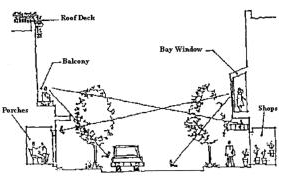
An active street that is human scale and attractive to pedestrians.
The rear of these buildings shall be designed so that they are also accessible from rear lot parking where necessary, and are not obtrusive to adjacent neighbors (UVC). Buildings shall avoid long, monotonous uninterrupted walls or roof planes. Buildings shall use articulation and/or modulation on all walls that are visible to pedestrians (UVC). Buildings occupying corners shall be designed as more dramatic structures to emphasize their prominent locations (UVC).
B. Guideline.
1. Building materials and colors may include any of the following:
a. Masonry, wood, stucco, concrete, stone, and tile, each broken into small modules (UVC);
b. Accent or trim colors are encouraged (UVC).
2. Building elements should employ the following:
a. Vertical and horizontal relief in the facade that identifies a bottom, middle and top of the building (UVC);
b. A clearly defined pedestrian entry facing the street (UVC);
c. Window systems grouped together to form larger areas of glass separated by moldings or jambs (UVC); and
d. Awnings, canopies, marquees, building overhangs, or similar form of pedestrian weather protection at least four and one-half feet wide along at least eighty percent of the frontage of buildings that abut a pedestrian street (UVC).

Align the bottom edge of awnings, canopies or marquees on a group of buildings so that the unity of the store front line is maintained with adjacent buildings.
3. Building Proportions – Size, Height and Bulk.
a. Use design techniques that minimize the apparent size of the building such as:
i. Building stepbacks on upper levels (UVC);
ii. Curved or articulated surfaces (UVC);
iii. Recessed entries (UVC);
iv. Roof lines, pitches and shapes (UVC);
v. Cornices (UVC);
vi. Building ornamentation (UVC);
vii. Overhangs and soffits (UVC);
viii. Dormers, balconies and porches that clearly define street-facing entries to residential properties (UVC);
ix. Building fenestration and detailing (store front or multi-paned windows for residential units) (UVC); and
x. Awnings and marquees (UVC).
b. Buildings on corner lots may be designed with additional height and architectural embellishments such as corner towers to emphasize their location (UVC).

Corner buildings should be designed as more dramatic structures to emphasize their prominent location.
4. Exterior Wall Treatments.
a. Consider providing accessible views into interior activities of office and commercial buildings from the street. For example, use a high proportion of clear glass at the street level or have displays or services directly available from the street where appropriate (UVC).
b. In mixed use buildings, the difference between ground floor commercial uses and entrances for upper level commercial or residential uses may be reflected by differences in facade treatment. Differentiation can be achieved through distinct but compatible exterior materials, signs, awnings and exterior lighting (UVC).
c. One or more of the following wall treatments are required for building faces fronting on a sidewalk that exceed thirty feet in length, and should cover or comprise at least sixty percent of the building face between two and eight feet in elevation above the sidewalk.
i. Clear or lightly tinted windows that are transparent when viewed from the sidewalk (UVC);
ii. Ornamental and structural architectural details: mosaic, decorative masonry or tile, surface texture, relief art work, sculpture or murals (UVC);
iii. Climbing plants, vines, trees or other vegetation (UVC); or
iv. A pedestrian area located along the southern, eastern, or western exposure of a building face at a transit stop, intersection corner, or other location identified in an adopted streetscape plan may substitute for the wall treatments listed above (UVC).
(Ord. 534 (2016) § 7(5) (App. E) (part), 2016)
17.480.080 Building design – Creation of human scale.
A. Requirement. Use design elements that result in buildings that maintain a human scale street. These design elements are also useful and should be considered when commercial buildings abut residential development (UVC).
B. Guideline.
1. Use rooflines to maintain a consistent and apparent scale, and reinforce or create architectural character on a street (UVC).
2. Use architectural features such as cornices or other details that lower the apparent height (UVC).
3. Use modulation (stepping back and stepping forward) and articulation on building facades to reduce the bulk of buildings (UVC). Articulation methods include:
a. Broken rooflines; and
b. Building elements such as balconies, chimneys, porches or other entry details, and landscaping.
4. Place display windows and retail shops at the street level around the exterior of larger buildings (UVC).
(Ord. 534 (2016) § 7(5) (App. E) (part), 2016)
17.480.090 Building design – Building wall finishes for stand alone and corner site buildings.
A. Requirement. Ensure buildings have consistent visual identity from all sides visible to the general public (UVC).
B. Guideline. Continue exterior materials, architectural detailing, and color scheme around all sides of the building visible to the general public (UVC).
(Ord. 534 (2016) § 7(5) (App. E) (part), 2016)
17.480.095 Building design – Commercial use with ancillary drive-through component.
A. Requirement. Locate the main entry to a bank, dry cleaner, coffeehouse, or other commercial use with ancillary drive-through component on a pedestrian-oriented street. Orient drive-through facilities in a way that ensures minimal disruption on the street edge. Such commercial uses with an ancillary drive-through component are prohibited from locating directly on the street that surrounds the center park or square (UVC).
B. Guideline.
1. Design the drive-through window so that it is clearly subordinate to the main building (UVC);
2. Where the drive-through is a separate structure, use architectural details that conform to those used on the main building (UVC);
3. Minimize curb cuts and the disruption of a sidewalk by:
a. Making the width of the lane approaching the window as narrow as possible; and
b. Using landscaping and planters to provide a street edge adjacent to the sidewalk (UVC).
(Ord. 534 (2016) § 7(5) (App. E) (part), 2016)
17.480.100 Landscape design for urban village and town centers.
A. Requirement. Treat plantings and other landscape elements as enhancements to the built environment. Street trees shall be planted along at least one side of all streets (UVC).
B. Guideline.
1. Employ any of the following planting techniques for landscape design:
a. Small planting areas with flowering shrubs (UVC);
b. Trimmed hedges, window boxes, hanging flower baskets (UVC);
c. Use of shrubs or vines trained to grow upright on wires or trellises (espaliers) next to blank walls with narrow planting areas (UVC);
d. Isolated trees installed in pavement cutouts (UVC);
e. Street trees should be massed at critical points such as at focal points along a curve in a roadway (UVC);
f. Low maintenance, low chemical dependent drought-tolerant plant materials should be used (UVC);
g. Repeat similar tree and shrub types to coordinate old and new phases of development and provide visual continuity (UVC);
h. Limit varieties of plant types, use shrubs in multiples of similar types, and avoid a haphazard mixture of textures, colors and plant types (UVC);
i. Include a well-landscaped surface storm water treatment area in the landscape design where surface storm water treatment is provided (UVC);
j. Retain natural greenbelt vegetation that contributes to greenbelt preservation (UVC);
k. The owners will provide regular maintenance to ensure that plants are kept healthy and dead or dying plant materials are replaced (UVC);
l. Landscape open areas created by building modulation (UVC);
m. Incorporate upper story planter boxes or roof plants into facades that can be seen by pedestrians (UVC); and
n. Emphasize entries with special planting in conjunction with decorative paving and/or lighting (UVC).
(Ord. 534 (2016) § 7(5) (App. E) (part), 2016)
17.480.110 Landscape design – Screening.
A. Requirement. Use landscaping to help define, break up and screen parking areas. Landscaping shall provide a separation between incompatible land uses or activities (such as a parking lot next to the bedrooms of a residential structure). Landscaping shall also provide a physical or visual barrier for service areas, mechanical equipment, loading docks or similar areas (UVC).
B. Guideline.
1. Canopy trees (able to spread and shade) should be added to parking areas – there should be no more than six parking spaces in a row without a landscape peninsula within the parking area having a two-inch caliper tree, shrubs, and ground covers (UVC).
2. Wheel stops, curbs, or walkways should be used to protect landscaping from being run over by vehicles in the parking lot (UVC).
3. Consider screening with the use of hedges, densely planted shrubs, evergreen trees, or combinations of these (UVC).
4. Screen parking from the street with low walls or fencing that maintain building facades, but also maintain vehicular sight lines at the corners and security for customers (UVC).
5. If fencing is required, repeat the use of facade building materials on fence columns and/or stringers (UVC).
6. Berms, walls and fences are encouraged in combination with trees, shrubs and vines to screen parking lots (UVC).
7. Raised planter boxes of concrete, stone, wood, brick or other compatible materials can provide useful separation and screening (UVC).
8. Locate appropriate landscape materials near building walls or service areas where screening is needed. Large planters may be used as alternative solutions (UVC).
9. Planters may be placed at the end of bays, on the interior or between rows of parking stalls, providing linear strips for plantings. Use of compact parking spaces as allowed provides some flexibility in design (UVC).
10. Unrelieved blank walls with narrow planting areas can be softened with espaliered shrubs or vines (UVC).

Vines, hardy shrubs and columnar trees used to landscape a narrow planting bed.
(Ord. 534 (2016) § 7(5) (App. E) (part), 2016)
17.480.120 Landscape design – Existing trees.
A. Requirement. Healthy existing trees, that are unique due to size, species, historical association or other factors, shall be incorporated into the landscaping whenever possible and if appropriate to the site at their mature size (UVC).
B. Guideline.
1. Retain healthy mature trees where possible (UVC);
2. Design the site to preserve unique specimens (UVC);
3. Minimize site alteration, soil disturbance, and compaction within the drip line of existing trees (UVC);
4. Provide a tree well or other form of protection where the surrounding grade must be raised (UVC);
5. Fence around drip line during construction (UVC); and
6. Incorporate the tree plan into the landscape plan (UVC).
(Ord. 534 (2016) § 7(5) (App. E) (part), 2016)
17.480.130 Signs – Attached to the building.
A. Requirement. Provide adequate signs for businesses while maintaining the building’s architectural integrity, by locating signs so that building details shall not be covered or obscured (UVC). Signs shall conform to the requirements set forth in Chapter 17.510.
B. Guideline.
1. Use sign panel shapes that accentuate the building’s architectural forms (UVC);
2. Use window signs where wall signs would detract from architectural elements of the building facade. Symbols for the business such as a pair of eyeglasses can be used to add detail that can be viewed from the sidewalk (UVC);
3. Keep signs subordinate to the building design (UVC);
4. Coordinate colors with the colors of the building (UVC);
5. When several businesses share the same building, use directory signs where possible and use similar sizes and types of signs (UVC); and
6. Addresses must be clearly visible from the street edge (UVC).
(Ord. 534 (2016) § 7(5) (App. E) (part), 2016)
17.480.140 Signs – Freestanding.
A. Requirement. Provide adequate signage for businesses when building mounted signs cannot be used because they will obscure the architectural details of the building (UVC). Signs shall conform to the requirements set forth in Chapter 17.510.
B. Guideline.
1. A key design feature should be a compact building pattern with buildings located close to and behind the sidewalks and street trees separating the sidewalk from moving vehicles. In an effort to reduce the number of view obstructions in village and town centers, signs should be attached to the building. However, where buildings are set back from the sidewalk and/or property line, freestanding signs would be an appropriate second choice using the following guidelines:
a. Freestanding signs should be limited in size and height. The maximum height should be four feet above grade (UVC);
b. For visual clarity, the lettering style and colors should be limited to two lettering styles and three colors (UVC); and
c. Incorporate signs in planters or as screening walls (UVC).
(Ord. 534 (2016) § 7(5) (App. E) (part), 2016)
Article 3. Multifamily Projects in the UVC Zone (Including Townhouses of Five Units or More)
17.480.150 Multifamily – Site design – Orientation.
A. Requirement. Design multifamily projects to be oriented towards the core area or center park/plaza in the village (UVC).
B. Guideline.
1. Use a modified street grid system with buildings fronting on a street (UVC).
a. Parking areas should be located behind or under buildings and accessed from alley-type driveways. If driveway access from streets is necessary, minimum-width driveways meeting the fire access standards should be used (UVC);
b. Each building should have direct pedestrian access from the street fronting the building and from the back where the parking is located (UVC).
2. Another alternative may be to orient the buildings into U-shaped courtyards where the front door/main entry into the building is from a front courtyard. Access to the courtyard from the rear parking area should be through a well-lighted breezeway or stairway. This alternative will work where projects abut an arterial or major collector street where the quality of living could be enhanced with buildings facing into the courtyard. The buildings would still be located between the street and the parking lot (UVC).
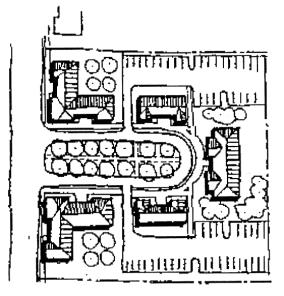
(Ord. 534 (2016) § 7(5) (App. E) (part), 2016)
17.480.160 Multifamily – Site design – Parking location and design.
A. Requirement. Minimize the impact of driveways and parking lots on pedestrians and neighboring properties by designing and locating parking lots, carports, and garages in a way that creates few interruptions on the street, sidewalk or building facade (UVC).
B. Guideline.
1. Locate surface parking at rear or side of lot (UVC);
2. Break large parking lots into small ones, and share with adjacent property owners where possible (UVC);
3. Minimize the number and width of driveways and curb cuts (UVC);
4. Share driveways with adjacent property owners (UVC);
5. Locate parking in areas that are less visible from the street (UVC);
6. Locate driveways so they are visually less dominant (UVC);
7. Berm and landscape parking lots when they are visible from the street (UVC);
8. Screen parking lots abutting single-family residences with landscaping and/or fencing (UVC); and
9. Limit parking lots on street frontages to thirty percent of the street frontage (UVC).
(Ord. 534 (2016) § 7(5) (App. E) (part), 2016)
17.480.170 Multifamily – Site design – Mailboxes, site lighting, and bus stops.
A. Requirement. Provide adequate lighting and pedestrian access to mailboxes, and bus stops (UVC).
B. Guideline.
1. Mail Boxes. If common mailboxes are used, they should be located near the project entry or any recreational facilities, as approved by the U.S. Postal Service. The architectural character should be similar in form, materials, and colors to the surrounding buildings. Mailboxes should be well lit and pedestrian-accessible (UVC).
2. Site Lighting.
a. Site lighting (pedestrian-scale, low-level lighting) should be provided throughout, and located at the walkways (UVC);
b. Security lighting should be provided in the parking areas, play areas and bus stops (UVC);
c. Lighting should not shine into the dwelling units on the site (UVC); and
d. Lighting should be directed away from neighboring development (UVC).
(Ord. 534 (2016) § 7(5) (App. E) (part), 2016)
17.480.180 Multifamily – Site design – Screening.
A. Requirement. Provide adequate screening for support facility needs associated with multifamily developments (UVC).
B. Guideline. Support areas should be located adjacent to parking areas and should be fully screened with a minimum six-foot-high fence. The screening material should match the main buildings, and the perimeters planted with shrubs and ornamental trees (UVC).

Service elements located away from the street edge and not generally visible from the sidewalk.
(Ord. 534 (2016) § 7(5) (App. E) (part), 2016)
17.480.190 Multifamily – Building design – Neighborhood scale.
A. Requirement. Architectural scale of those portions of a multifamily building facing a neighborhood with a different scale shall use design techniques that minimize the contrast in scale (UVC). [See illustration below.]
B. Guideline.
1. Use house-size building elements when locating a multifamily project adjacent to a single-family neighborhood by employing any of the following techniques:
a. Place one- and two-story units adjacent to existing one-story houses, and two- and three-story units adjacent to existing two-story houses (UVC);
b. Use wall plane articulation/modulation to break a multifamily building into house size building elements, especially where there is a building height transition (UVC);
c. Design the exterior of multifamily buildings to appear as a single building, such as a large single-family detached dwelling (UVC).
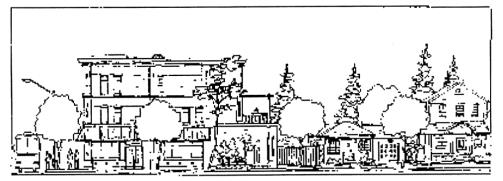
This higher density multifamily building “steps back” to conform to the abutting lower density property. This use of modulation helps the multifamily building fit into the neighborhood.
Preferred: This is a multifamily building which has been built on an identical site, but whose design has taken clues from the neighborhood. This building covers roughly the same lot area and provides for the same number of units while appearing as if it “fits” in its surroundings.

To be avoided: This multifamily building has been built on a site surrounded by single-family development. The building bears no resemblance to the existing surrounding buildings and looks out of place.
(Ord. 534 (2016) § 7(5) (App. E) (part), 2016)
17.480.200 Multifamily – Building design – Privacy.
A. Requirement. Orient buildings to provide privacy, to the extent practical, both within the multifamily project and for the neighborhood (UVC).
B. Guideline.
1. Locate windows so that residents from one unit cannot look directly into another unit (UVC);
2. Locate parking lots so that they do not impose on the ground floor units’ privacy. If this is not feasible, locate buildings so that adequate landscaping can be planted to provide privacy (UVC).
(Ord. 534 (2016) § 7(5) (App. E) (part), 2016)
17.480.210 Multifamily – Building design – Facade, footprint, and roof articulation.
A. Requirement. Avoid the barracks-like quality of flat walls and roofs by separations, changes in plane and height, and the inclusion of elements such as balconies, porches, arcades, dormers, and cross gables (UVC).
B. Guideline.
1. Buildings should be divided and given human scale by using articulation and/or modulation at least every thirty feet. Ways to do this include the following:
a. Facade modulation – stepping back or extending forward a portion of the facade at least six feet (measured perpendicular to the front facade), for each interval (UVC);
b. Articulating each interval with architectural elements like porches, balconies, bay windows and/or covered entries (UVC);
c. Articulating the roofline by stepping the roof and by emphasizing dormers, chimneys, gables (UVC); and
d. Providing a ground or wall mounted light fixture, a trellis, a tree, or other site feature within each interval (UVC).
2. Reduce the apparent size of multifamily buildings by using:
a. Roof design that employs:
i. Gable, gambrel or hipped roof;
ii. Broken or articulated roof line;
iii. Prominent cornice or fascia that emphasizes the top of the building; or
iv. Other roof elements that emphasizes a building’s concept and enables it to fit in with neighboring structures with prominent roofs (UVC);
b. Using architectural details that are well proportioned to achieve human scale such as:
i. Entry details like covered porches and recesses;
ii. Occupiable spaces like bay windows and balconies;
iii. Window details like vertically proportioned window openings that are recessed into the face of the building and broken up with smaller panes of glass;
iv. Roof details like brackets, chimneys, roof overhangs of at least sixteen inches (measured horizontally), or roof cornice elements at least twelve inches in width (measured vertically);
v. Windows that are trimmed to create relief in the facade by being detailed to appear to recede into the building face (UVC).
3. Where parking structures or covered parking faces the street, at least sixty percent of the parking facade facing the street between two and eight feet above the sidewalk should incorporate at least one of the following treatments where pedestrian-oriented businesses are located along the facade of the structure (UVC):
a. Transparent windows (with clear or lightly tinted glass);
b. Display windows;
c. Decorative metal grille work (or similar detailing) that provides texture and covers parking structure openings (not including entrances and exits); or
d. Art or architectural treatment such as sculpture, mosaic, glass block, opaque art glass, relief art work, or similar features.
4. Vehicle entries to garages should be recessed at least six feet from the primary facade plane in order to minimize their prominence (UVC).
(Ord. 534 (2016) § 7(5) (App. E) (part), 2016)
17.480.220 Multifamily – Building design – Entries.
A. Requirement. Provide clearly defined building or courtyard entries that are well lighted, easily accessible, and satisfy the Washington State Barrier Free Regulations (UVC).
B. Guideline. The entrances should be plainly visible from the fronting street and walkway. The use of distinctive architectural elements and materials to denote prominent entrances will be encouraged. The entries should include a transition space from the sidewalks such as steps, a terrace, or a landscaped area (UVC). Dark, hidden corridors or stairways and long entry balconies are discouraged (UVC). Avoid the use of exterior stairways when porches and front doors can be used as a primary building entry. If exterior stairways are used, they should fit with the architectural massing and form of the multifamily structure. Thin-looking, open metal, prefabricated stairs are discouraged (UVC).
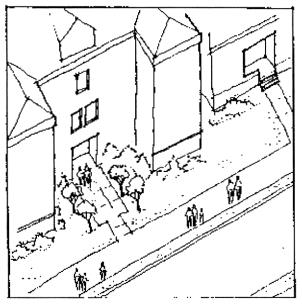
Clear entries to the sidewalk encourage pedestrian circulation.
(Ord. 534 (2016) § 7(5) (App. E) (part), 2016)
17.480.225 Building design – Windows.
A. Requirement. Provide relief, detail, and variation on the facade by employing well-proportioned openings (as defined in the guideline in subsection (B)(1) of this section) that are designed to create shade and shadow detail.
B. Guideline. Provide horizontal and vertical variation in windows. Bay and projecting windows are encouraged.
1. Use vertically proportioned windows that generally have a height one and one-half times their width;
2. Use multiple-paned windows;
3. Build windows either recessed or protruding (such as bay windows);
4. Use significant trim (drip cap, sill, trim); and
5. Provide ground floor windows that have a greater vertical height than upper story windows.
(Ord. 534 (2016) § 7(5) (App. E) (part), 2016)
17.480.230 Multifamily – Building design – Materials and colors.
A. Requirement. Use exterior building materials that have texture or pattern and lend themselves to a high level of quality and detailing.
B. Guideline.
1. The selection and use of exterior materials and colors are key ingredients in determining how a building will look. Some materials, by their nature, can give a sense of permanence or provide texture or human scale that enables new buildings to fit better in their surroundings (UVC). Use exterior materials that are durable, easily maintainable and are attractive even when viewed up close.
2. Preferred materials in Kitsap County include:
a. Clear/painted horizontal or lap siding;
b. Shingles;
c. Brick;
d. Stone;
e. Stucco;
f. Stucco-like exterior insulation finish systems, used in small modules; and
g. Ceramic or terra cotta tile.
3. Bright or intense colors should be reserved for accent or trim. Colors should be chosen to visually reduce the size of buildings that are larger than others in the neighborhood. Changes in wall colors should differentiate the ground floor from the upper floors.
4. Changes in materials on larger buildings should be coordinated with articulation and modulation within the building’s architecture. Changes in the building materials can also be used to differentiate the ground floor from upper floors of the building and should vary from building to building in multi-building projects (UVC).
(Ord. 534 (2016) § 7(5) (App. E) (part), 2016)
17.480.240 Multifamily – Signs.
A. Requirement. Minimize the amount of signage needed to identify the multifamily development (UVC). Signs shall conform to Chapter 17.510, Sign Code.
B. Guideline.
1. Multifamily projects should have a sign at the main entry from the street to identify the project. The sign should also include the street address (UVC).
2. Internal directional signs showing the building locations and building numbers are encouraged (UVC, NC).
3. Each building will have clearly displayed street numbers, building numbers, and building name, if applicable. Choose materials for the signs that are used in the architectural details of the buildings (UVC).
(Ord. 534 (2016) § 7(5) (App. E) (part), 2016)
Article 4. Other Residential Development in the UVC Zone: Duplex and Manufactured Housing, Cottage Housing and Single-Family Housing
17.480.250 Duplexes and manufactured housing – Applicability.
Sections 17.480.250 through 17.480.290 apply to duplexes and manufactured housing within the UVC zone.
(Ord. 534 (2016) § 7(5) (App. E) (part), 2016)
17.480.260 Duplex – Building design – Roof form and architectural detail.
A. Requirement. Design residences to reinforce the architectural character of the village (UVC).
B. Guideline.
1. Create architectural character in the village or centers through the use of the following:
a. Roof design. Pitched or articulated roof line, or other roof elements such as eyebrow roof forms or dormers that emphasize building form and help it to fit in with neighboring structures with prominent roofs (UVC).
b. Architectural details that are well proportioned to achieve human scale such as:
i. Entry details like porches and recesses;
ii. Occupiable spaces like bay windows and balconies;
iii. Window details like vertically proportioned window openings which are recessed into the face of the building and broken up with smaller panes of glass;
iv. Roof details like brackets, chimneys, roof overhangs of at least sixteen inches (measured horizontally);
v. Windows that create relief in the facade by being detailed to appear to recede into the building face (UVC).
(Ord. 534 (2016) § 7(5) (App. E) (part), 2016)
17.480.270 Duplexes – Building design – Entries.
A. Requirement. Provide clearly defined building entries or entry courtyards that are well lighted and easily accessible (UVC).
B. Guideline.
1. The entries should include a transition space from the sidewalks such as steps, a covered porch, a terrace, or a landscaped area (UVC).
2. Entries should include, at a minimum, eave overhangs extending at least sixteen inches (measured horizontally) and covered porches (UVC).
3. Avoid the use of exterior stairways when porches and front doors can be used as a primary building entry. If exterior stairways are used, they should fit with the architectural massing and form of the multifamily structure. Thin looking, open metal, prefabricated stairs and railings are discouraged (UVC).
(Ord. 534 (2016) § 7(5) (App. E) (part), 2016)
17.480.280 Duplexes – Building design – Garage design.
A. Requirement. Design garages and carports in a way that does not dominate the dwelling’s front facade. If an alley exists, the garage or carport shall be located off the alley. Otherwise, garages and carports shall be located behind the residence with or without a partial view from the street, or stepped back from the facade of the building, or located below sidewalk grade (UVC).
B. Guideline.
1. The entrance to a residence should be plainly visible from the fronting street and the walkway and should not be dominated by a garage or carport (UVC).
2. Driveways should be as narrow as possible and shared where possible to minimize disruption of the sidewalk and planting strip by curb cuts. The use of wheel tracks or a grass/concrete porous pavement system is encouraged (UVC).
3. Garage sidewalls that face the street (e.g., as a result of garages being aligned at an angle or perpendicular with the house) should appear to contain habitable space. This can be accomplished by incorporating windows and other design elements into the garage wall that are in character with the remainder of the dwelling (UVC).
(Ord. 534 (2016) § 7(5) (App. E) (part), 2016)
17.480.290 Duplexes – Building design – Materials and colors.
A. Requirement. To use building materials on exteriors that are durable, easy to maintain, are of human scale and that are attractive even when viewed up close. These include materials that have texture, pattern, or lend themselves to a high level of quality and detailing (UVC).
B. Guideline.
1. Preferred materials that could be used in a village include (UVC):
a. Clear/painted/stained horizontal lap siding;
b. Shingles;
c. Brick;
d. Stone;
e. Stucco;
f. Stucco-like exterior insulation finish systems, used in small modules;
g. Ceramic or terra cotta tile.
2. Preferred roofing materials include: composition or wood shake shingles, standing seam nonglare metal, or tile (UVC).
3. In multi-building projects materials and colors should be varied from structure to structure to provide variety and interest to the streetscape. Bright or intense colors should be reserved for accent or trim. Colors should be chosen to visually reduce the size of buildings that are larger than others in the neighborhood (UVC).
(Ord. 534 (2016) § 7(5) (App. E) (part), 2016)
Article 5. Accessory Dwelling Units (ADU) in the UVC Zone
17.480.300 Accessory dwelling units – Site and building design – Privacy.
A. Requirement. To the extent practical, maintain privacy of adjoining residences, and the primary residence (UVC).
B. Guideline. Use a combination of landscape screening, fencing and window and door placement so that ADU residents cannot look directly into the windows, porches and decks of adjoining residences (UVC).
(Ord. 534 (2016) § 7(5) (App. E) (part), 2016)
17.480.310 Accessory dwelling units – Building design – Entry features.
A. Requirement. Provide a clearly defined building entry, which is well lighted, easily accessible and integral to the building structure (UVC).
B. Guideline.
1. Entries should be plainly visible from the fronting street sidewalk (UVC);
2. If the entry cannot be seen from the fronting street sidewalk, a well-defined walkway (e.g., constructed of contrasting materials or lined with a pattern of shrubbery) should be used to “lead” the visitor to the entry of the ADU (UVC);
3. Where an ADU is added within an existing primary residence, entry may be off an existing foyer (UVC);
4. Where there is a separate entry, an identifying feature, such as a portico, porch, stoop and/or eave overhang or a similar entry structure shall be constructed that is designed to be integral to the structure (UVC);
5. Walkways, entry porches, or stairways that are dark or hidden are to be avoided (UVC);
6. Where an exterior stairway to the main entrance to the ADU is needed or a porch, portico, or eave overhang constructed, it should be constructed of wood, or the most common material used in the construction of the primary residence. Thin looking, open metal, prefabricated stairs are discouraged (UVC).
(Ord. 534 (2016) § 7(5) (App. E) (part), 2016)
17.480.320 Accessory dwelling units – Building design – Materials and colors.
A. Requirement. Ensure that ADUs conform to the design theme of the village, and contribute to the livability of the neighborhood (UVC).
B. Guideline.
1. Use a roof form and roof pitch, and window and door form and arrangement that looks like the primary residence (UVC);
2. Use the same exterior materials (roof, siding, and trim) and a color that matches the primary residence (UVC);
3. In general, the roof ridge of the primary residence should be higher than the ADU. An obvious exception is when the ADU is built onto the second story of an existing unit (UVC).
(Ord. 534 (2016) § 7(5) (App. E) (part), 2016)
Article 6. Cottage Housing in the UVC Zone
17.480.330 Cottage housing – Site design.
A. Requirement. Design cottage housing to use shared off-street parking, orienting the cottages to the street edge and to the shared interior courtyard (UVC).
B. Guideline.
1. Entryways should be oriented to the public street, with secondary entries oriented to the shared courtyard (UVC);
2. Parking should be shared and accessed off an alley or secondary street wherever possible (UVC);
3. The width of the driveway curb cut entry to the parking areas should be minimized to prevent as much pedestrian/sidewalk disruption as possible (UVC);
4. Provide pedestrian connections from the interior courtyard to the shared parking area and to the street and sidewalk (UVC).
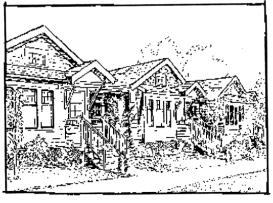
Cottage Housing
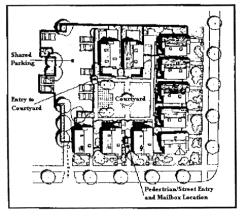
Cottage Housing
(Ord. 534 (2016) § 7(5) (App. E) (part), 2016)
Article 7. Definitions
17.480.340 Reserved.
(Ord. 534 (2016) § 7(5) (App. E) (part), 2016)


